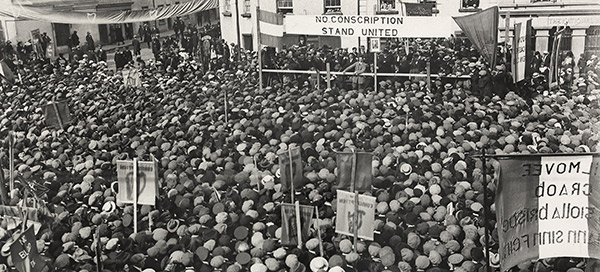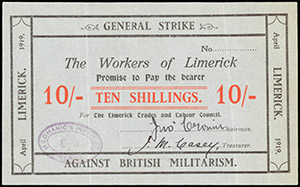Was the War of Independence necessary?
Published in 20th-century / Contemporary History, Issue 1 (January/February 2019), Platform, Revolutionary Period 1912-23, Volume 27Labour’s 1918 anti-conscription ‘Plan of Action’—an alternative strategy for independence?
By Padraig Yeates
In 1918 the Irish Labour Party and Trade Union Congress (ILP&TUC) proposed methods of passive resistance to conscription that could have been adapted by Dáil Éireann to pursue the struggle for independence in 1919, rather than allowing the country to be catapulted into an armed conflict for which it was militarily unprepared and whose widespread military and sectarian violence caused lasting damage to relations between North and South, not to mention between Ireland and Britain for another century.
Military resistance to conscription in 1918 would have been futile. If membership of the Irish Volunteers soared during the crisis, weapons remained pitifully scarce. Dramatic plans by Cathal Brugha to assassinate members of the British cabinet and by the Dublin Brigade to convert the city’s tenements into ‘fortresses’ that could be defended with home-made bombs and hand grenades may have given militant nationalists a sense of purpose but they were expressions of desperation, not serious strategic options.
On the other hand, the ILP&TUC’s ‘Plan of Action’ was practical and mercifully bereft of the ‘blood sacrifice’ mentality. It called for a director or small executive committee tobe established in each British military district with ‘full power to act’ locally and be responsible for communications with other areas.
The key proposals were:
- Withdrawal of bank deposits by ‘merchants, farmers, shopkeepers, clergy and all classes’ to stimulate economic pressure on the government.
- Rail workers to stop for proscribed periods, ‘a week or fortnight’ at a time, forcing the military to deploy resources to maintain the transport infrastructure.
- ‘All postal officials, civil service clerks, police’ and ‘local authority workers’ to ‘down tools’.
- Appeals to rank-and-file soldiers for sympathetic action.
It argued that a nationwide stoppage would ensure that no area was left to bear the brunt of military attention, and would ‘demonstrate to the world that the nation was united in its resolve to resist at any cost’. Such action would also be undertaken ‘in the hope’ that ‘a sympathetic reaction will take place among the Irish population in industrial Britain.’
These measures had been accepted in principle by the Mansion House Conference in April 1918, except,predictably, the withdrawal of bank deposits. Napoleon notwithstanding, we were, far more than Britain, a nation of shopkeepers. Sinn Féin and the Irish Volunteers were represented on the organising committee by Arthur Griffith and Éamon de Valera.
Unlike the subsequent Sinn Féin policy of boycotting the RIC, Labour argued that ‘If police and civil servants can be persuaded to act with the people the battle can be won’. The country would become ‘ungovernable’ and ‘all the force of the nation’ would ‘be used to ensure re-instatement without penalties of all civil servants after the struggle’.
Under the heading of ‘Food Harvest’, the Labour memorandum advised that ‘Farmers and dealers should be warned against sending any grain, roots, pork or live stock to market for shipment out of the country. Grain to be kept in stack as long as possible so as to render commandeering more difficult. The country must aim at supplying home needs, not to ship food while the crisis lasts … we must use the most effective economic weapons we have.’ It further proposed that local committees‘consider issuing licences to dealers who will guarantee to trade only for home consumption’. As mentioned earlier, the ILP&TUC was particularly concerned about the vulnerability of the capital to military pressure. This was borne out during the War of Independence, when 20% of internees were from Dublin.

Rather than engaging in attacks on British forces, the plan proposed that ‘men of military age’ should remain indoors and not allow themselves ‘to be rounded up in groups as would happen if they gathered together in public places’. Passive resistance would not only prevent the military from using attacks as an excuse to terrorise and collectively punish communities but also force the British authorities to concentrate on maintaining essential services.
Acknowledging that food supplies would be a major problem, and recognising that the Great Northern Railway would continue to operate normally because of the antipathy of many loyalist National Union of Railway members, the memorandum said that this should be taken advantage of to bring food supplies into Dublin, along with seaborne traffic. It called on farmers in County Dublin and elsewhere to play their part in co-operating with the introduction of food rationing to ensure equity of sacrifice.
In a prefiguration of the Dáilloans, the Plan of Action proposed that payment for food supplies, and other essential goods and services, should be guaranteed by ‘the Nation … when the battle is over’. It said that arrangements for ‘Cork, Limerick, Waterford, Derry and the larger towns may follow on similar lines’ to Dublin, except that they would have to rely primarily on sea and road transport rather than rail.
There were, of course, many forms of passive resistance between 1919 and 1921, such as the Limerick Soviet called in April 1919 in response to the military curfew, the refusal of transport workers to allow the export of foodstuffs after price controls were lifted in March 1920, and the boycott of the motor permits regime. Most successful of all was the general strike in support of republican hunger strikers in April 1920, which led to the release of all political prisoners. The munitions strike in May 1920 severely hampered British military operations throughout the second half of the year. In fact, it was so effective that it had to be called off in December, as the economy approached collapse in many parts of the country. The successful establishment of the Dáil courts and the arbitration system to regulate land, industrial and other disputes undermined British authority to such an extent that many Southern unionists and businessmen became reconciled to the idea of dominion status, if not a republic.

These initiatives, however, were not part of an overarching strategy directed from the centre, as had been envisaged in the anti-conscription campaign of 1918. They resulted mainly from local initiatives, not unlike the emerging guerrilla campaign, and by 1921 Dáil Éireann and the IRA were intervening more frequently than the British authorities to end strikes and occupations and to close down ‘soviets’, even though the latter were usually established in pursuit of better pay and conditions rather than to overturn the established order.
By contrast, military activity was largely counterproductive in terms of mobilising popular support for independence. In fact, the last general strike, in April 1922, was against‘militarism’ by pro- and anti-Treaty IRA factions. Moreover, it contributed deeply to heightening sectarian tensions in the North, which exploded in the pogroms of 1920. The Dáil Éireann response, the Belfast Boycott, only deepened the divide, while the decision by Michael Collins to set up an Irish Engineering,Shipbuilding and Foundry Workers Trade Union was a deliberate attempt to split the trade union movement.
It is unlikely that anything done by Dáil Éireann could have successfully wooed Northern loyalist opinion, but the failure to explore the sort of options outlined in the 1918 ILP&TUC plan was a missed opportunity to give greater ownership of the struggle for independence to the wider community. Instead, small self-electing and ultimately self-serving groups of militants filled the vacuum and dictated the political agenda of the South for most of the coming century.
Ironically, the success of the campaign against conscription meant that none of the measures proposed by the ILP&TUC received a trial run in 1918. Nevertheless,they do provide a glimpse of alternative strategies to those adopted during the War of Independence. A struggle for independence based on mass passive resistance would have left us with a more broadly based democracy and a more benign historical legacy than the one we ultimately inherited.
Padraig Yeates is the author of A city in civil war: Dublin 1921–4 (Gill and Macmillan, 2015).
















